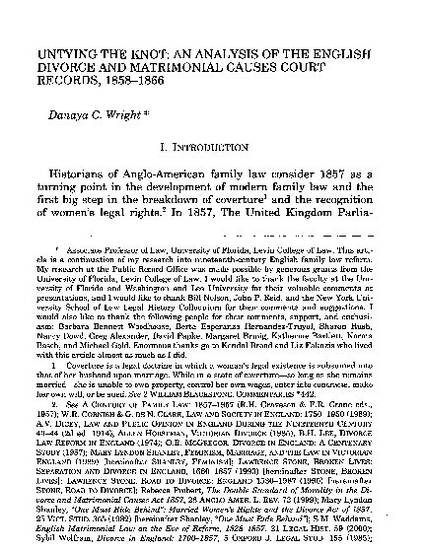
Historians of Anglo-American family law consider 1857 as a turning point in the development of modern family law and the first big step in the breakdown of coverture and the recognition of women's legal rights. In 1857, The United Kingdom Parliament ("Parliament") created a new civil court to handle all divorce and matrimonial causes, removing the jurisdiction of: the ecclesiastical courts over marital validity; the Chancery over custody of children and separate estates; the royal courts over marital property; and Parliament over full divorce. The new Divorce and Matrimonial Causes Court, a wing of the admiralty and probate courts, would handle all matters familial beginning in 1858.
The 1858 divorce court was the first attempt in the Anglo-American legal system to create a court specially dedicated to the family, a court that would take a holistic approach to what was perceived in the 1850s to be a social and moral crisis -- the so-called divorce epidemic among the wealthy, and the exclusion from divorce by a rapidly-growing, vocal middle class. And although many aspects of women's disabilities under coverture remained intact in the new court, married women's demands for legal reform and independent legal rights influenced much of the reform rhetoric.
The creation of the court marked the final shift in the modern secularization of divorce and an acceptance of the appropriateness of judicial oversight in matrimonial affairs. The creation of a civil court to handle these varied aspects of legal divorce was a rejection of ecclesiastical and legislative control over the marital relationship as well as a unification of family property, custody, and marital status. The property rights of the parties would become intertwined with the custody needs of children and an ethic of marital fault. For over a century, marital fault would become the focus, the key to divorce, a determinant in property distributions, and a major factor in determining the best interests of children. The administrative logistics of negotiating the breakdown of the marital relationship would be made simpler and less costly, thus making the remedy available to a wider class of litigants. The new court dealt the final death blow to the ecclesiastical courts and the highly selective and guarded parliamentary divorce. Its rules were the precursor to modern family law and led the way toward the creation of specialized family courts, whose procedures and rules were believed to minimize the animosity, destructiveness, and expense of traditional adversarial litigation.
